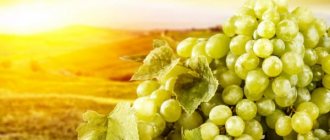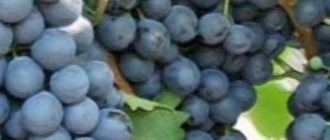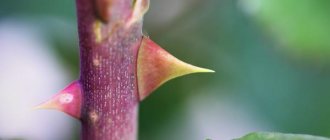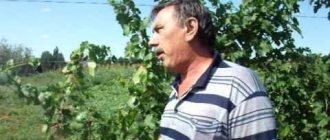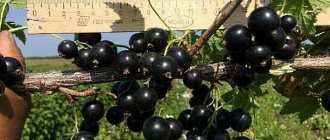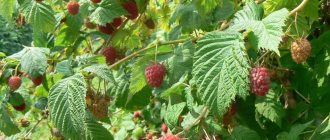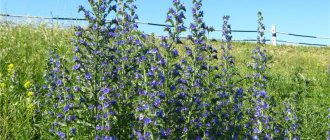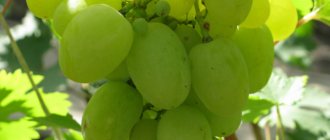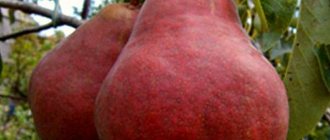Lydia grapes are a technical variety once widely used in winemaking. The berries of this variety are characterized by the specific taste and aroma of forest grapes. Let's find out why this ancient variety is interesting and is it worth growing?
grape variety "Lydia"
“Lydia” grapes have a pleasant strawberry taste and an unsurpassed aroma
grape variety "Lydia" has a high yield percentage
History of the appearance of the variety
Lydia is a selection product obtained from seedlings of the species V. Labrusca, brought from North America. It was from here that wild grapes were brought to Europe, and with them phylloxera and oidium (an insect and fungal disease, respectively). Moreover, the “foreigner” itself, unlike European varieties, was resistant to these scourges.
To save grapes from death, breeders began to graft them onto the North American “savage”. Lydia is a hybrid species obtained by crossing a parent pair - the “American” Vitis labrusca and the “European” Vitis Vinifera.
Phyloxera is an insect pest from North America that attacks grapes, except labrusca varieties.
Ban on wine production
In the middle of the last century, the variety was popular in the USSR, especially in Moldova and Ukraine. Here it was grown over vast areas as a technical variety. Thousands of tons of wine were produced from Lydia. But at the end of the 20th century, an increased content of methyl alcohol was discovered in wines made from “Lydia” and “Isabella”.
It was found that the berries of these varieties contain a lot of pectin. When fresh, the fruits do not pose a threat, but during fermentation, pectins are transformed into methanols, which damage the liver, kidneys, optic nerves, and can even lead to death.
Since 1999, the use of Lydia for wine production has been banned in the United States and the European Union. Whether wine made from this grape is actually more harmful than wine made from other varieties is not known for certain, since any alcohol can have a negative effect on the body. Perhaps the ban on wine production is just a competitive ploy.
What type does it belong to?
Lydia is usually classified as a universal variety. The harvest can be harvested after 150-160 days from the growing season, which allows Lydia to be classified as a variety with an average berry ripening period. Thanks to its good taste, the grapes produce high-quality homemade wine.
Grapes are also grown for preparing homemade dishes, salads, compotes, and baked goods.
Korolek, Galahad and Attica are also used to make homemade wines.
In magazines and online articles it is often classified as two types: table and technical.
Botanical description of Lydia
Brief botanical description of "Lydia":
- Bushes. Medium size, highly thickened. 80% consist of fruiting shoots. The leaves are large, heavily pubescent, dissected into 3 or 5 lobes. The flowers are bisexual.
- Bunches. Loose, have several branches. Small in size, cylindrical in shape. Average weight – 100 g.
- Fruit. Round, red, with a pink-violet tint. The pulp has a slimy consistency, juicy, with a characteristic strawberry aroma. Weight – up to 4 g. The skin is dense, covered with a waxy coating. The diameter of the berry is 15 mm.
The gardener provided a video review of the “Lydia” grape variety:
Pruning a grape bush
From the second year of the plant’s life, it is recommended to form a vine of the Lydia variety - pruning three times a season.
In the spring, the procedure is carried out for sanitary purposes - dried shoots are cut off. Pruning can only be done at a constant temperature of at least +5˚ C and always before the juices begin to flow.
In summer, the pruning procedure helps to thin out the Lydia grape bush. Stepchildren are cut to improve ventilation of the vine.
Advice! It is better to start pruning in the fall in October-November.
The first time the shoot of the Lydia variety is cut off at the level of 2-4 eyes. Every year the cutting height rises - 8 buds, then 15 buds. The recommended load on a Lydia grape bush is 36-49 buds.
Advantages and disadvantages
“Lydia” is not particularly valued by gardeners - the taste of its berries is clearly not for everybody, but this variety has enough advantages - it’s not for nothing that it was once so popular.
Advantages:
- bears fruit steadily and abundantly;
- frost-resistant;
- tolerates soil waterlogging well;
- berries do not crack at high humidity;
- has high immunity to a number of grape diseases;
- suitable for decorative use;
- capable of self-pollination;
- Thanks to the dense skin of the berries, it is easily transported.
Flaws:
- it is necessary to regularly prun the bushes and trim off excess shoots, which tend to grow rapidly;
- harm to the body is possible if the wine preparation technology is violated;
- berries are prone to shedding when ripe - it is important to harvest in a timely manner.
Today, “Lydia” is practically not grown on an industrial scale - the vineyards have been cut down. The variety can be found in personal gardens, but even here its demand is constantly falling. Increasingly, the variety is used as a cheap landscaping product.
Isabella grapes – the benefits and harms of nature’s gift
Isabella and Lydia are grape varieties with sonorous and memorable names that bear fruit well not only in large vineyards at wineries, but also in our dachas. The area of cultivation of these varieties is quite wide, from the south to the middle zone and even northern latitudes. By the way, the colder the climate, the fewer but sweeter the berries. Both varieties do not require special care; they are resistant to diseases characteristic of modern and more noble grape varieties.
They have good frost resistance, so they do not require shelter for wintering. The Isabella variety is a self-formed hybrid that was discovered by the American botanist V. Labrusque in the forests of South Carolina (USA). The berries are medium-sized and round in shape. The clusters are dense and weighty. The skin is dense, matte, dark blue, almost black. The dullness of the grapes is given by the so-called “natural wax”, which prevents rotting of the fruit.
Isabella grapes taste a little tart with pronounced sourness. There is enough sugar to make good wine. Although in some countries the production of a “sun drink” from this variety in industrial quantities is prohibited by law.
Characteristics of the variety
The “Lydia” variety is distinguished by powerful, fast-growing bushes capable of producing dozens of bunches annually. Let's take a closer look at the main characteristics of this grape.
Productivity and fruiting
The variety is very productive, despite the small clusters. Up to 120 centners are collected from 1 hectare. One bush produces up to 40 kg of grapes. High yield is associated with excellent ripening of the vine - 4-6 full-fledged bunches grow on one shoot. Moreover, there is no need to standardize the bushes - they can withstand the load of the harvest without any problems.
The variety belongs to the late-ripening category. The berries take a long time to ripen – about 160 days. In temperate climates, the harvest is ready around mid-September. To ensure that the ripe berries are juicy, sweet and as large as possible, the bushes are watered regularly. Ripening is unfriendly - the clusters facing the sun are the first to ripen.
Drought resistance and winter hardiness
Compared to most European varieties growing in the south, “Lydia” has increased frost resistance. The variety can withstand frosts down to minus 26°C. For the winter, the bushes are covered, otherwise, in severe frosts, freezing is possible.
"Lydia" tolerates drought well, but only short-term. If the bushes experience a lack of moisture for a long time, this will affect the berries - they will be small and sour.
Resistance to diseases and pests
The variety is resistant to mildew and oidium. It is affected by calcareous chlorosis - it usually develops with iron deficiency in the soil, as well as anthracnose and gray mold. Unlike its American ancestor, "Lydia" is affected by phylloxera. Among the pests dangerous to “Lydia” are spider mites and leaf rollers.
Application area
“Lydia”, like most Isabel varieties, belongs to the technical group. Its purpose is the preparation of dessert wines, strong wine materials, and juices. The fruit is also eaten fresh, used for preparations - preserves, marmalade, marmalade, jelly, and other culinary delights.
Places of growth
The variety is European, so it is not designed for harsh Russian winters. Previously, these grapes grew in Ukrainian and Moldavian vineyards. The variety grows well in the southern regions of Russia. In more northern regions, insulation is required.
This unpalatable technical variety has never been in demand in temperate climates - requiring insulation, it does not have qualities that are interesting to gardeners and consumers. And after information about the dangers of wine from “Lydia”, interest in the variety diminished even more.
Transportability
The variety is characterized by excellent transportability. Thanks to the thick skin, the berries do not spoil during long-term transportation. If stored appropriately - in refrigerators at +8°C, the bunches can be stored for up to two months.
Features of cultivation and care
The key to a high yield is timely watering. So, at the beginning of the growing season, it is necessary to moisten the soil around the bush well, this will give additional strength for the development of buds.
After the grapes have bloomed, they also need to be watered abundantly for better fruit formation. We must not forget about watering in especially dry weather, since without moisture the berries can be small and sour.
This variety loves moisture and tolerates a slight excess.
To retain moisture around the root, it is necessary to mulch the soil with a layer of grass, peat, humus, and sawdust. This will prevent the water from evaporating and will serve as additional fertilizer.
Fertilizers
Like any grape variety, “Lydia” needs timely fertilization with nitrogen, potassium and phosphorus.
Trimming
Pruning helps shape the bush and increase its yield.
Therefore, professional gardeners recommend shortening the bush by 6–8 buds . It is worth remembering the need to cut off unnecessary stepsons and chase shoots in the second half of June.
Frost resistance
The variety can withstand frosts down to -26 degrees, but you should not neglect its shelter in winter.
Despite the frost resistance of the variety, the shoots should be covered for the winter.
The young shoot is covered with soil, a layer of at least 10 cm. An adult plant can be wrapped with polyethylene. However, during warming, air must flow under the film so that the plant does not die due to accumulated moisture.
Preparation and planting
The "Lydia" grapes do not require special conditions for planting.
Terms and Conditions
Seedlings are planted at any time - in spring or autumn. Each option has its own characteristics:
- Spring. Grape seedlings are planted in April-May. Over the summer, the young animals will get stronger and prepare for wintering. The disadvantages of spring planting are frequent heavy watering and the possibility of return frosts.
- Autumn. Disembarkation time is October. The seedling will take root before frost and adapt to new growing conditions. The downside is the risk of damage from the first frosts, so seedlings should be carefully covered.
Buying seedlings in the spring is not easy - nurseries usually sell planting material in the fall.
Conditions for planting seedlings:
- soil temperature – from +10°C;
- air temperature – from +15°C.
The soil and pits are prepared in advance. For spring planting - from autumn. But if the holes were not prepared in the fall, they are dug in the spring - about a week before planting. During this time, the soil will have time to settle at least a little.
Planting material
Today, few people plant “Lydia” as seedlings - this variety is excellently propagated by cuttings, which do not require spending money on. The survival rate of cuttings is 100%.
Planting cuttings depends on the climate:
- In the southern regions, cuttings can be planted in the fall directly into soil that has been fertilized and dug up. Then they are covered and left until spring. Out of 10 cuttings, at least 7-8 will take root successfully.
- In regions with cold winters, seedlings can be grown from cuttings planted in pots. You can plant cuttings, for example, in cut plastic bottles.
The procedure for preparing cuttings for spring planting.
- The tendrils, leaves and shoots are removed from the shoots.
- Cut cuttings 40-45 cm long. Each cutting has 3-4 eyes.
- The cuttings are placed in water at room temperature for 24 hours.
- A day later, the cuttings are taken out, sprayed with potassium permanganate and dried in air.
- The cuttings are wrapped in polyethylene and sent to the cellar for storage. Recommended temperature – from 0 to +2°С.
In February or March, the cuttings are taken out of the cellar and proceed to the second stage of preparation:
- The cuttings are placed in water for two days.
- The cuts are made using pruning shears. One is 3-5 mm from the lower eye, the second is 2 cm from the upper. These cuts increase the chances of germination.
- Having removed the lower bud, the upper one is dipped into molten paraffin, and then into cold water so that the paraffin hardens. This event is aimed at protecting planting material from bacteria.
- Make four cuts at the bottom of the cutting. The length of the cuts is 3 cm. The main thing is not to damage the wood, you just need to pry off the bark. Once the cutting is planted, roots will grow from these cuts.
Planting site and soil
Requirements for planting site and soil:
- The best option is chernozems or sandy loam soils with an acidity pH of 6–7.
- The depth of groundwater is at least 1.5 m.
- The area should be illuminated by the sun during the day.
- There should be no drafts or piercing wind.
Planting stages
The first stage of planting is preparing the seat:
- Prepare the hole in advance - it must stand for some time so that the soil settles. The width and depth of the pit is 80-90 cm.
- Place broken bricks, pebbles, crushed stone or expanded clay at the bottom of the hole - this will be a drainage layer. Layer height – 15-20 cm.
- Prepare the nutritional mixture. To do this, mix the top fertile layer removed when digging a hole. A mixture of soil and fertilizers is poured over the drainage in a layer of 30 cm. Composition of the soil mixture:
- fertile soil – 1 part;
- river sand – 1 part;
- humus – 1 part;
- nitrophoska – 50 g;
- double superphosphate – 50 g;
- ammonium nitrate – 20 g.
- Then add the remaining soil to the hole - the roots of the seedling must not come into contact with fertilizers.
- Water the soil with hot water (70-80°C). For one hole - a bucket.
- After 5-6 days you can start planting. It is advisable to plant seedlings in the evening or on a cloudy day.
The second stage is planting a seedling:
- Place a seedling at the bottom of the hole. Despite the shrinkage of the soil, it must be taken into account that it may still settle a little. The root collar must be positioned so that it is above the surface of the earth.
- Fill the seedling halfway with soil. Pour warm water (+25°C). The “heel” of the seedling should be 40 cm away from the ground surface.
- After waiting for the water to be absorbed, add more soil so that about 15 cm remains to the edges of the hole. Create this depression for further watering.
- Compact the soil and water it. Watering rate is 20 liters per seedling.
- When the moisture is absorbed, loosen the soil and sprinkle with mulch. This will prevent crust formation, moisture evaporation and weed growth.
On the north side you can put a support for a young seedling - on the north side.
Grafting cuttings onto rootstocks
The procedure for grafting onto the rootstock:
- In autumn, take cuttings with 2-3 good eyes.
- Store the cuttings. Until spring they are kept in a container with sand at a temperature of +12°C.
- When the time comes to graft, cut both sides of the cutting. Cover the upper end of the cutting with paraffin to retain moisture, and place it in water or humate to form roots.
- Remove the old bush, leaving 5-8 cm above the ground.
- Clear the cut of the bush from debris. Make a cut in the center and place the cutting there.
- Tie the grafting site with woven material and cover it with clay.
- Water the rootstock and mulch the soil.
Transfer
Grape bushes, if necessary, can be replanted. Such a need may arise if the grapes shade some plant or simply grow out of place. Grapes are replanted early in the spring - before sap flow begins, or in the fall - after the leaves fall. The grapes are replanted by transshipment - with their own lump of earth.
To prevent the lump of earth from falling apart during transshipment, they stop watering the bush 2 days before transplanting.
Transfer order:
- Dig around the bush around the circumference (d=50 cm).
- Prepare the pit in advance. Its size should be such that the root system along with a lump of earth can freely fit in it.
- Pour double superphosphate (200 g), potassium salt (30 g), humus - 7 kg, and ammonium sulfate (100 g) into the new hole.
- Remove the bush from the soil.
- Roll into the new hole. Proceed carefully so that the lump of earth around the roots does not fall apart.
Caring for grapes "Lydia"
When the seedlings are planted, the gardener’s task is to provide the crop with everything necessary for growth. “Lydia” is unpretentious, but its productivity, taste and size of fruits directly depend on the quality of care - watering, fertilizing, pruning and other agrotechnical measures.
Shaping and trimming
Principles of pruning “Lydia”:
- From the second year of life, the formation of the bush begins. Pruning is carried out three times per season.
- In the spring, sanitary pruning is done - dried, diseased and damaged shoots are cut off.
- In summer, pruning is carried out to thin out the bushes. Stepchildren are cut to improve ventilation of the bushes.
- In the fall, in October-November, pruning is carried out - the first year by 2-4 eyes, then by 6-8 eyes, then by 15. From 35 to 50 eyes are left on an adult bush.
Pruning is carried out before the start of sap flow, at a temperature of at least +5°C.
For “Lydia” a fan shape is suitable. If the bush grows excessively, fruiting deteriorates. In a fan formation, the bush has one or more main branches growing from the ground. The vines from the branches are distributed along the trellises in different directions. The vine bush is similar in shape to a fan.
Formation begins in the 2nd year after planting the seedlings, and it ends in the 4-5th year of life. Forming features:
- In the first year, the bush is pruned in October, leaving only 2-3 shoots.
- In the second year, pruning is carried out in the spring - before the buds open. 3 eyes are left on the vines - in the lower part. By autumn, at least three strong vines should grow on the bush - they are tied to a trellis. The gaps between tiers are 30-40 cm.
- In the third year, 3-4 eyes are left at the bottom of the vine - if there are 2 shoots on the bushes. If there are 3 shoots on the bush, then two are put on the sleeves, new branches are grown from the third, leaving 3 eyes on it. A bush with four strong shoots is formed like this - all 4 shoots are tied to trellises, forming sleeves with a slight slope. Having removed the upper eyes, 3 are left - for the formation of new vines for next year.
- In the fourth year, the bush is pruned similarly to the third year - fruit-bearing branches and second-order sleeves are created from the sleeves. All other shoots are pruned. To get new sleeves, remove the upper shoot from the old ones, leaving only 2 lower ones. The sleeves are tied to the trellises.
- In the fifth year, the formation of the bush is completed. The arrows that do not produce a harvest are removed - in their place new links are formed from replacement knots.
You can learn more about spring pruning of grapes from this article.
Watering
Regular watering is a condition for rapid growth and high yield of “Lydia”. To water the bushes, grooves 20 cm deep are dug along the diameter of the tree trunk circles. The watering norm for one bush is 12-15 liters.
Approximate timing of watering Lydia grapes:
- in spring, after pruning;
- after tying branches to trellises;
- when shoots grow 25 cm long;
- before flowering;
- after flowering;
- during ripening;
- after harvesting the grapes.
The soil around the grape trunks is loosened after each moistening.
Fertilizer and feeding
To ensure that the berries gain sugar content, the bushes are fed throughout the growing season. Fertilizers are applied in solid form - during digging of the soil, or in dissolved form - during watering.
Fertilizer application scheme:
| Period | Feeding |
| March | For a bucket of water:
|
| 2 weeks before flowering | Same as in March. |
| Before ripening | For a bucket of water:
|
| After harvest | For 1 sq. m: potassium chloride – 15 g. |
Loosening and katarovka
Near the trunk, the soil is loosened - within a radius of about half a meter. Loosening is necessary to supply oxygen to the roots of the grapes. It is recommended to loosen the soil once every half month.
Once a year - at the end of spring or at the beginning of summer, a catarrh test is carried out. This event involves removing thin superficial roots growing at a depth of 20-25 cm. The procedure is carried out with sharp pruning shears. This is a difficult undertaking, since inept actions can lead to damage to the roots and death of the bush.
Thanks to catarrh, the plant is able to survive in the most difficult conditions. This event allows the bush to recover even after the death of the entire above-ground part.
Preparing for winter
The variety is relatively frost-resistant, but to reduce the risk of frost damage, it is better to insulate it for the winter. Cover the plantings in November using the usual method:
- remove branches from trellises;
- they lay them on the ground and tie them up;
- covered with earth - a hill 10-15 cm high should form;
- to strengthen the structure, it is supported on the sides with boards.
Bird protection
"Lydia" berries do not have high taste characteristics, but birds like them. To protect the harvest from birds, special caps are put on the bunches - you can buy them or make them yourself, for example, from disposable plastic plates. The caps prevent birds from reaching the berries, and the harvest is preserved.
Birds can also be repelled using optical, sound, visual or combined methods. Experienced gardeners also advise placing several drinkers on the site - perhaps the birds are just thirsty, and because of this they are pecking at the berries.
Productivity and ripening time
When planting a vineyard with self-rooted seedlings in the 2-3rd year after planting, the plant blooms and produces signal clusters; marketable fruiting begins in the 4th year, when one bush produces an average of 5-7 kg.
According to the results of experimental tests in the natural conditions of Tashkent (planting pattern 2.5 × 2.0 m with a fan formation), five-year-old plantings demonstrated a yield of 5-7 kg per bush or 8-14 t/ha (2000 bushes per 1 ha) .
When cultivating “Lydia” in Kakheti, a yield of 7-7.5 t/ha was recorded
Removable maturity occurs 140-160 days after bud break . The taste and aroma are revealed in the last ten days of September - mid-October. Full ripeness of berries in the regions of western Georgia is observed in the second half of October, but the harvest begins in mid-September.
The berries are weakly held on the stalks, but the tendency to massive shedding is observed mainly in strong gusty winds. If weather conditions are favorable, the clusters may hang until the first autumn frosts.
The slimy pulp, delicate in structure, is well protected from damage by a strong skin, which is not damaged during transportation. If harvested in a timely and competent manner, the fruits do not spoil and are stored in the refrigerator for more than 2 months. When hung, the clusters are preserved well even until February, but the taste of the berries gradually deteriorates, they wrinkle and fall off easily.
The opinion of an experienced Ukrainian gardener about the yield potential of “Lydia” can be found in the following video:
Diseases and pests
The “Lydia” variety is resistant only to some diseases (mildew, oidium), and therefore requires preventive treatment.
Diseases of Lydia grapes and measures to combat them:
| Diseases | Symptoms | How to treat? | Prevention |
| Gray rot | There is a gray coating on the bunches. The berries are rotting. | Spraying with soda solution (70 g of soda per bucket). Removing affected bunches. | Pruning for good ventilation. |
| Anthracnose | The leaves have brown spots with a dark border. The affected tissues die. | Spraying with Ridomil (per 10 l - 25 g), Horus (per 10 l - 3 g). | Cleaning up plant residues. |
| Calcareous chlorosis | The leaves turn yellow, but the veins remain green. The tissues dry out and the bush does not develop. | Spraying with Antichlorosin (concentration before flowering 0.1%, after flowering - 0.15%). | Choosing a rootstock taking into account soil carbonate content. |
| Black spot | The bark loses color and small black dots appear on it. Young shoots are most often affected; dark spots appear on the first 6-7 internodes. | Spraying with Topaz - one ampoule per bucket. | Preventing mechanical damage. |
Pests of Lydia grapes and measures to combat them:
| Pests | Signs of damage | How to fight? | Prevention |
| Phylloxera | There are swellings on the underside of the leaves. The bushes develop poorly. | Spraying with Confidor (per 10 l - 2 ml). | The use of fine-grained sand during planting - it is poured into the hole around the seedling. |
| Spider mite | On the underside of the leaves there is a thin cobweb. The leaves turn yellow, dry out, and fall off. | Spraying in spring with DNOC (per 10 l - 150 g). In August - Phosfamide (per 10 l - 20 g). | Regular weeding. |
| leaf roller | Caterpillars eat berries. The leaves are gnawed. | Spring treatment of soil and plants with insecticides, for example, DNOC. | Good lighting and ventilation of the bushes. |
Reviews from gardeners about grapes
★★★★★
Knysh N., Barnaul. Many people don’t like the taste of Lydia, but I really like these berries.
There is a minimum of care for it, and there is a harvest under any circumstances. The main problem is wasps. ★★★☆☆
Kirill O., Bryansk.
I consider Lydia to be a morally obsolete variety. For me it serves as a decorative barrier, nothing more. The berries are tasteless, even juice and wine retain a specific taste. Today there are dozens of more interesting varieties, but this one has long been in the dustbin of breeding history.
★★★★★
Dimon, Bryansk
Kirill from Bryansk, I completely disagree with your point of view! The Lydia variety is a super variety!
★★★★☆
Ivan and Irina
My wife and I have been growing this variety for about 5 years. We really like it. The taste is normal and the wine is good.
Hide
Add your review
Whatever experts say about the harm of wine from “Lydia”, this old technical variety will delight our gardeners for a long time with its harvest and coolness. This grape is so undemanding and productive that it will always find its fans.
0
0
Copy link

